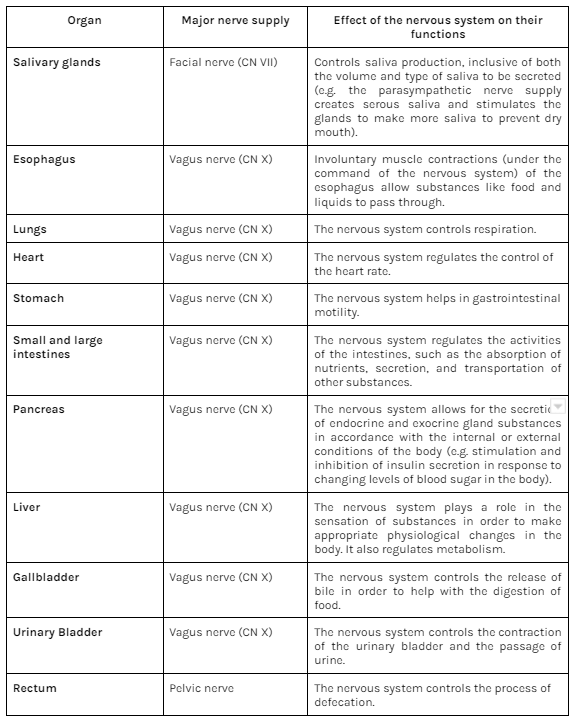1. You have been to an ‘eat all you can’ buffet and have consumed large amounts of food. After returning home, you recline on the couch to watch television. Which division of the nervous system will be handling your body’s after-dinner activities? List several organs involved, the major nerve supply to each organ, and the effects of the nervous system on their functions.
The division of the nervous system that will be handling the after-effects of the day’s activity (eat all you can buffet) would be the parasympathetic nervous system.
The parasympathetic nervous system, also known as the rest-and-digest system, controls the body during times of rest and relaxation; it increases the rate of digestion and diverts energy in order to help the body digest food.
The organs involved in this process, their major nerve supply, and the effect of the nervous system on their functions, are the following:

In summary, almost all organs that play a significant role in the parasympathetic nervous system’s control of bodily functions (specifically digestion in this context) are controlled by the cranial nerve X, also known as the vagus nerve. Said nerve, also known as the longest nerve, evidently has both afferent and efferent roles in the body.
2. Your friend is driving home from work, listening to her favorite music, when suddenly a bicycle came out of nowhere. She manages to swerve avoiding hitting the bicycle. She continued to drive home but she noticed that her heart is beating fast, she had goose bumps, and her heads were sweaty. How would you explain these effects?
Coming from a state of defensive driving while listening to her favorite music (which originally calmed her nerves down and had her in a relaxed state), having a bicycle come out of nowhere and almost being in an accident with the said bicycle would have rattled the friend, put her in a state of panic, and had her stressed out. Her response to the situation, which included an increased heart rate and goosebumps (indicating erected arrector pili muscles) is due to the response of the sympathetic nervous system to the situation at hand. The sympathetic nervous system, the body’s fight or flight system, increases a person’s movement, strength, and wakefulness as a response to stressful situations that threaten a person’s survival.
References:
McCorry, L. K. (2007, September). Physiology of the Autonomic Nervous System. American Journal of Pharmaceutical Education, 71(4), 78. https://doi.org/10.5688/aj710478
Tortora, G. J., & Derrickson, B. H. (2020, December 22). Principles of Anatomy and Physiology, WileyPLUS NextGen Card with Loose-Leaf Set Single Semester (16th ed.). Wiley (WileyPLUS Products).